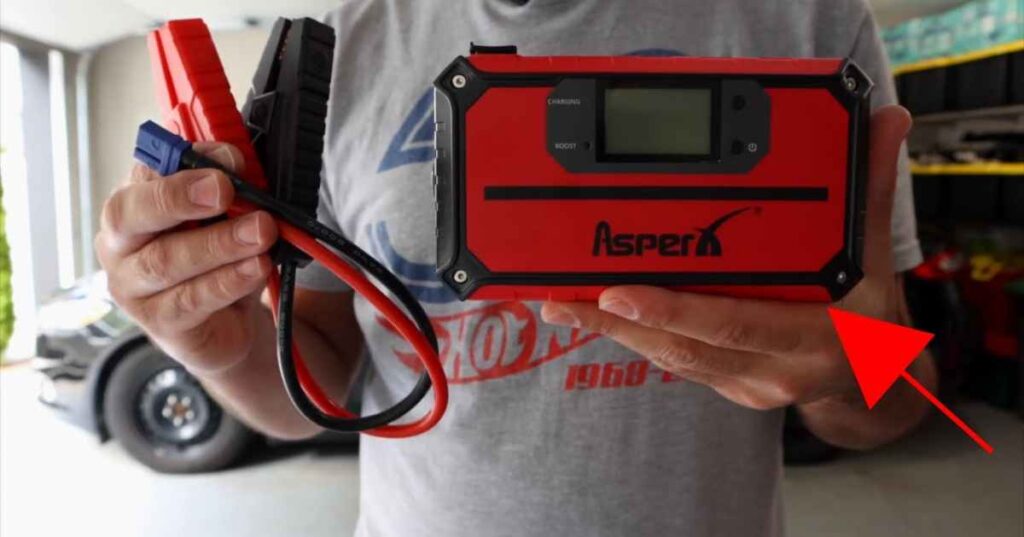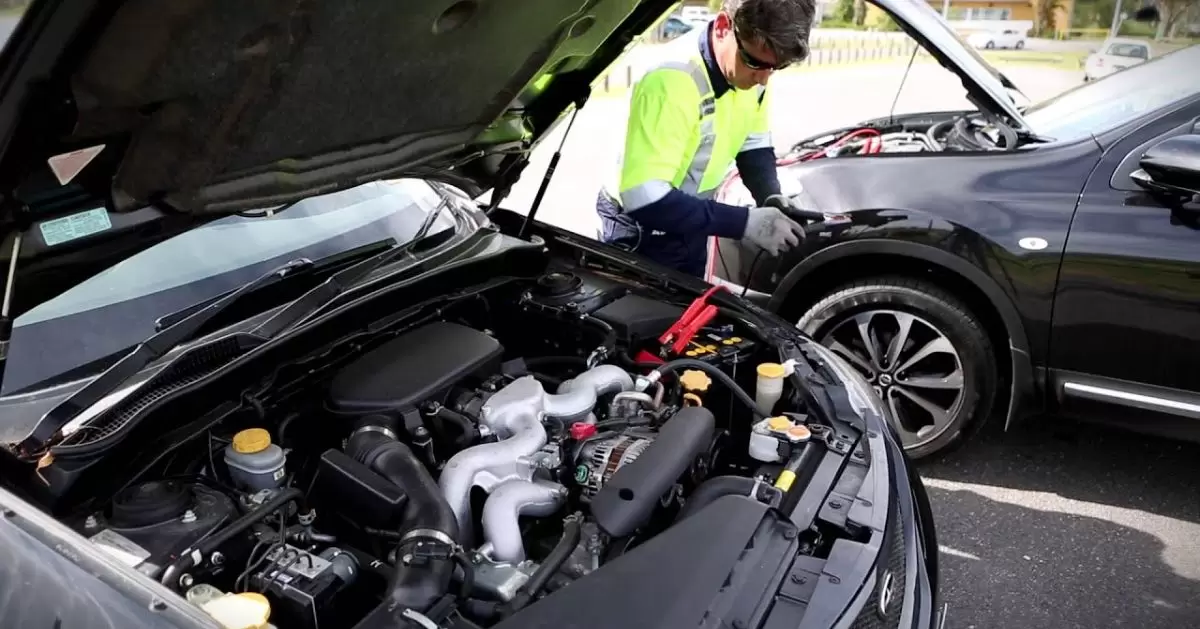Jump-starting a car is a method of starting a vehicle with a dead battery by using power from another vehicle’s battery. To jump-start your car, you’ll need jumper cables and another vehicle with a working battery.
Simply connect the positive (+) and negative (-) terminals of both batteries with the cables, start the working vehicle, let it run for a few minutes, then try starting your car. Once your car starts, disconnect the cables carefully in the reverse order.
What you’ll need to jump start a car
To jump-start a dead car battery, the main things needed are:
- Jumper cables (also called jump leads or boost leads) – sturdy copper cables with clamps on each end for connecting batteries.
- A car with a running/charged battery to provide a power source – it’s best if this “good” battery is in a similar sized vehicle to the car with the dead battery.
- Safety equipment like gloves – jumping a car involves connecting live batteries and you don’t want to risk electric shocks.
Using jump leads safely
It’s important to follow some safety steps when using jumper cables:
- Make sure both vehicles are in Park (or Neutral for manual transmissions) and emergency brakes are on to avoid rolling.
- Turn off all accessories like headlights, radio in both infinity cars to avoid extra load on the batteries.
- Don’t allow clamps to touch each other or to touch any other metal parts when connected to batteries.
- Connect positive clamp to positive terminal, negative clamp to negative terminal to avoid sparks.
A step-by-step guide to jump starting a car
Follow these steps when using jumper cables to start a dead car battery:
Line up both cars
Pull the vehicle bumper to bumper so the batteries are as close as possible to maximize current. Engage parking brakes.
Connect the red jump lead
Clip one end of the positive jumper leads to the positive terminal of the good battery.
Connect the black jump lead
Clip the other positive lead to the positive post of the dead battery.
Start the other car
Start the engine of the vehicle with the good battery and let it run for a few minutes at around 2000RPM.
Start your car
Now attempt to start the car with the dead battery by turning the key.
Turn off and disconnect
Once started, let both engines run for 5-10 minutes then disconnect leads in reverse order. First black then red ends from each respective terminal.
Restart your car
Ensure the car with the previously dead battery runs on its own before removing cables fully.
How to jump start a car with a battery booster pack

Battery booster packs like portable lithium jump starters are also useful for jump starting cars with a dead battery. The steps are similar but simplified:
Check the battery booster
Ensure the booster pack is sufficiently charged before use.
Connect the red jump lead
Connect the red positive clamp from the booster pack to the positive dead battery terminal.
Connect the black jump lead
Connect the black negative clamp to a solid metal grounding point like the engine block, away from the dead battery.
Switch on the pack
Turn the booster pack on and let it charge the dead battery for a few minutes.
Try to start the car
Crank the engine and it should turn over – if not, let it charge longer.
Turn off and disconnect
Once running, unclip the leads and stow the pack away. Try to drive normally to fully recharge the battery.
What to do after you’ve jump started your car
After resurrecting a dead car battery, it’s best to let the alternator fully recharge it as soon as possible. Drive the car for 30 minutes or more, using electrical accessories periodically if able.
This allows the alternator time to replenish the battery. If not recharged properly, the battery may fail again in days. You can also consider getting it tested afterwards by an auto parts store.
Can you jump start with a stop-start battery?
Stop-start batteries in hybrid and fuel-efficient vehicles have a different construction to regularly cope with repetitive short engine cycles. While they can generally be jump started like standard car batteries, there are a few additional points to note:
- Stop-start batteries have thicker plates to tolerate frequent cranking demands without damage. This impacts their voltage output under load.
- The charging system is calibrated for the specific battery type. Using a non-matching donor battery for jumping could cause voltage mismatches.
- If the stop-start battery has fully discharged, it may need very prolonged charging from an external source to recover. A standard jump may not adequately recharge it.
- Consult the owner’s manual guidelines. Some manufacturers do not recommend jump starting certain stop-start batteries at all if fully depleted.
Provided the jumper batteries used are in good condition and of a similar voltage rating, jump starting a lighter “micro-hybrid” stop-start system is generally safe.
But for strong hybrids, a battery charger may better suit their unique power characteristics. Caution is advisable to avoid further damaging these specialized batteries.
Does jump-starting a car damage the battery?

When performed properly following safety precautions, jump starting a car using jumper cables or a battery booster pack should not cause damage to a healthy vehicle battery. However, there are some potential risks that could shorten a battery’s life:
- Excessively low charge state – If a battery has been completely drained below a certain voltage threshold, it may not recover even after jump starting.
- Reverse polarity connection – Reversing the jumper cable clamps can cause significant burning and plate warping from high currents.
- Overcharging – Leaving jumper cables connected for too long at high engine RPMs overcharges the recovering battery.
- Old, low quality batteries – Weak batteries nearing end of life are more vulnerable to extra strain from jump starting.
Provided jump starting is done correctly to briefly get the vehicle running again, the battery should recover and recharge normally via short drive with no long term issues. But extensively run down or older batteries may never fully charge back up after jumping.
Frequently Asked Questions
What are the 5 steps to jumpstart a car?
The 5 steps to jumpstart a car are:
1. Position the cars
2. Connect the cables
3. Start the working vehicle
4. Wait a few minutes
5. Try starting the dead car.
What is the correct order to attach jumper cables?
The correct order to attach jumper cables is: Positive to positive, then negative to negative.
Which jumper cable goes on first?
The red (positive) jumper cable goes on first.
How do you manually jumpstart a car?
To manually jumpstart a car, connect the positive terminals of both batteries with a jumper cable, then connect the negative terminal of the good battery to a metal surface on the dead car’s engine. Start the working car and let it run for a few minutes before attempting to start the dead car.
Conclusion
With some basic tools and safety precautions, jump starting a car is a straightforward process that can get a vehicle up and running again when a dead battery would otherwise prevent it.
Simply follow the steps of connecting jumper cables or using a battery booster pack correctly to transfer power from a good battery and get the engine cranking until the alternator can fully recharge the weak battery.
